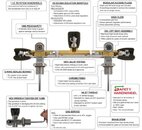cool_hardware52
Contributor
My understanding is that when one breathes from a regulator on a set of doubles with the isolator open, the gas delivered is drawn initially and primarily from the tank to which the reg is attached. There is a slight lapse (perhaps a second or two) between inhalation and the pressure being equalized as gas transits across the manifold to re-establish equilibrium. I do not believe there is any "mixing in the first stage."
Certainly would be interested to read the results of any experiment!
Nope. Just look at the internals of a manifold. The cross bar is about .08-.100" diameter. For the phenomena you describe you'd need a *tiny* hole, like the one in the reg end of a HP hose.
If what you suggest is true, the reverse, i.e. filling unequally, would also have to be true, and fill rates are often orders of magnitude greater than the rate at which a diver consumes gas.
If I'm filling ~200 cuft in 10 minutes that 20cf/min and using it at .5 cu ft / min the fill rate is 40 X the consumption. Any restrictions in the manifold would far more evident during filling.
If one introduces a single fill gas (O2, He, Air) via a single post do they not fill each tank equally? If not one would expect analysis of PP blended doubles to routinely differ from post to post. They don't if the manifold is cleared of the last gas introduced (short blast)
Try this: PP blend some EAN32 to 3000 PSI. Start with empty doubles. Slowly introduce 420 PSI of O2 via a single post. Slow, (good idea with O2 anyway), now we have absolutely the same amount of O2 in each tank.
Now blast in the ~2580 Psi of Air. Crank it. Clear each post (short blast out) and analyze.
If the manifold represents a restriction one would expect the Air to enter the tank "under' the post the whip was fitted to, mix a bit with the O2 there and then some of this "enriched air" would migrate over to the second tank. That would result in the "other" tank having a higher O2 % than the first. Doesn't happen.
Why? Gas moves from areas of high pressure to low pressure and even at the flow rates represented by rapid filling the manifold presents no significant restriction compared to the tank "under" the post the fill whip is attached to.
BTW I researched this very question when designing manifold extensions for some RB's with manifolded dil bottles.
Tobin





